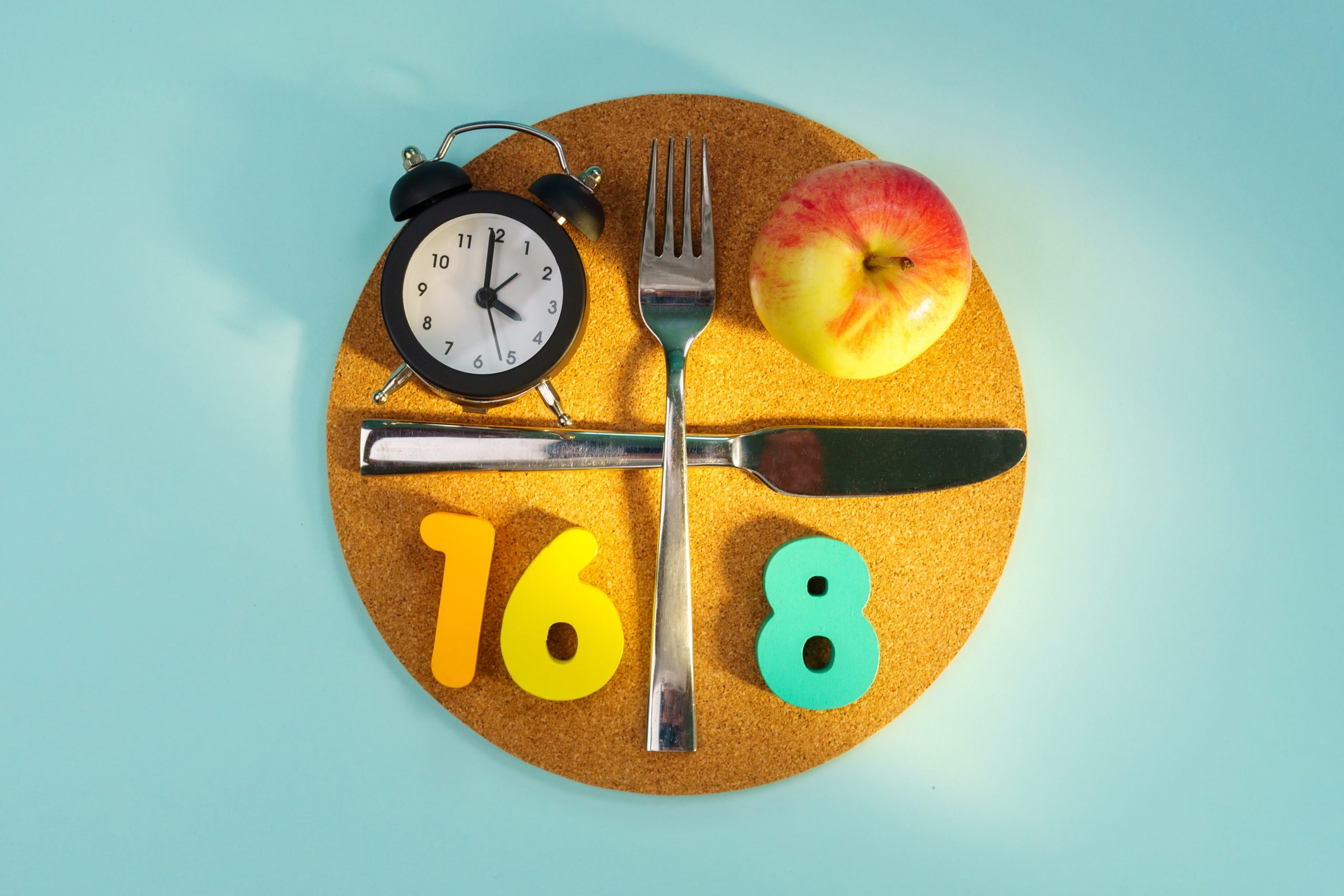
I’ve coached thousands of people through fat loss over the years, and one pattern I keep seeing is this: the best results come when structure meets flexibility. That’s why I started combining intermittent fasting and IIFYM and why it changed everything for me and my clients.
Intermittent fasting gives you control over when you eat. IIFYM (If It Fits Your Macros) gives you control over what you eat. When you bring the two together, you create a fat loss approach that’s not only effective but sustainable.
In this article, I’ll break down how intermittent fasting and IIFYM work separately and how they complement each other when used together. You’ll learn how to set them up, avoid common mistakes, and tailor both to your lifestyle and goals. I’ll also share what new research says and why this combo delivers better energy, fewer cravings, and more consistent results.
What Is Intermittent Fasting?
Intermittent fasting is simple. It’s about when you eat. Most of the time, I use the 16:8 method with my clients. That means fasting for 16 hours and eating within an 8-hour window. No need for six meals a day. No need to obsess over every snack.
You usually start eating around noon and stop by 8 PM. That’s it. It reduces the number of meals, cuts down mindless snacking, and naturally lowers calorie intake without making you feel like you’re dieting.
Some people try 5:2 fasting or alternate-day fasting. But in my experience, the 16:8 setup is the easiest to follow and the easiest to stick to.
When you fast, your body starts using fat for fuel instead of glucose. This switch helps you burn stored fat more efficiently. That’s one of the big reasons intermittent fasting supports fat loss, even without tracking every bite.
It also supports better insulin sensitivity and appetite control. And some research suggests fasting may promote autophagy, your body’s natural process for cleaning out damaged cells. That’s a bonus, even if your main goal is fat loss.
If you’re already tracking macros with IIFYM, fasting makes the process smoother. You’ll have fewer meals to plan and log, which makes it easier to hit your daily macro targets.
What Is IIFYM ?
I created IIFYM to give people an alternative to rigid meal plans. If it fits your macros, you can eat it. That’s the rule. You don’t need to avoid foods you love or stick to boring meals. As long as you hit your daily targets for protein, carbs, and fats, you’re good.
To start, you calculate your macros based on your age, weight, activity level, and goals. You can use our macro calculator to get those numbers quickly. Once you know them, you build your meals around those targets.
Protein is your foundation. It supports muscle, helps you stay full, and protects your lean mass while cutting fat. Carbs and fats support energy, recovery, and hormone balance. You get to decide how to split them based on what works best for your body.
Flexible dieting works because it gives you structure without strict rules. You don’t need to bring your own meals everywhere. You can go out with friends, travel, and still stay on track. It teaches you how to eat for your goals not just how to follow a plan.
Tracking macros builds awareness. You learn what foods are made of and how they affect your body. You can adjust your intake when needed. Whether you’re trying to lose fat or build muscle, your macros guide the way.
Use a macro tracking app to log your meals. The more you practice, the easier and faster it gets. It becomes second nature.
How Intermittent Fasting and IIFYM Work Together for Fat Loss?
I’ve seen firsthand how powerful intermittent fasting and IIFYM can be especially when you use them together. On their own, each strategy works. But when you combine time-restricted eating with macro tracking, the results often come faster and feel easier to maintain.
Fasting gives you structure. You’re not eating around the clock or thinking about food all day. That alone can reduce stress and improve focus. When you layer in IIFYM, you start optimizing the quality of those meals. You’re not just eating less. You’re eating better.
Fewer meals means fewer opportunities to slip up. In a shorter eating window, you become more intentional with every bite. You know what you’re eating, when you’re eating, and why. That level of clarity helps cut out mindless snacking and late-night cravings.
Adherence is everything in fat loss. That’s why this combo works so well. Intermittent fasting helps with satiety by spacing out meals and reducing insulin spikes. IIFYM keeps you full and fueled with the right mix of protein, carbs, and healthy fats. You’re not starving or depriving yourself. You’re eating with purpose.
Fasting can also improve insulin sensitivity and support fat-burning during fasting hours. When you combine that with dialed-in macros, you’re protecting lean muscle while shedding fat. That’s the real win.
| Training Stage | Muscle Gain Potential (Men) | Muscle Gain Potential (Women) |
| Novice | 1–1.5% of body weight (~1.5–2.5 lbs) | 0.5–0.75% of body weight (~0.65–1 lb) |
| Intermediate | 0.5–0.75% of body weight (~0.75–1.25 lbs) | 0.25–0.375% of body weight (~0.325–0.5 lbs) |
| Experienced | 0.25–0.375% of body weight (~0.375–0.625 lbs) | 0.125–0.1875% of body weight (~0.1625–0.25 lbs) |
Why This Combo Works Better Than Either Strategy Alone
I’ve broken it down like this for my clients:
- Intermittent fasting controls when you eat
- IIFYM controls what and how much you eat
- Together, they reduce calories and preserve muscle
- You get structure without restriction
- You make faster, more consistent progress.
It’s a flexible system that gives you real control without the burnout of traditional dieting.
Scientific Research Supporting Intermittent Fasting And IIFYM Combo
You don’t have to guess whether intermittent fasting and IIFYM work together. The science backs it. We’re seeing more studies that support this combo for fat loss, muscle retention, and better long-term adherence.
One of the most notable studies is by Isenmann et al. (2021). Researchers compared time-restricted feeding with macro-based dieting over several weeks. Both groups reduced calories and tracked protein intake. But the group using intermittent fasting plus macro tracking saw better results in body composition.
Here’s what stood out:
- Greater fat loss, especially around the waist
- No muscle loss, even in a calorie deficit
- Higher adherence rates people stuck with the plan longer
This mirrors what I see with clients. Fasting gives you a clear eating window. IIFYM adds structure to what’s on the plate. That combo reduces decision fatigue and keeps things simple without sacrificing flexibility.
Another study published in Cell Metabolism looked at early time-restricted feeding. Even without weight loss, participants improved insulin sensitivity, blood pressure, and oxidative stress markers. That means fasting supports metabolic health on its own.
Now layer in macros. A solid macro plan makes sure you’re getting enough protein to preserve lean muscle. It also gives you energy and recovery support by balancing carbs and fats based on your training and goals.
A 2020 review on flexible dieting also found that people who followed IIFYM principles were more likely to maintain their weight loss. Why? Because flexible control over food choices leads to better long-term behavior.
Key takeaways from the research:
- Intermittent fasting improves metabolic flexibility
- Macro tracking supports nutrient balance and muscle retention
- Together, they form a sustainable, effective system
You get results without rigid rules. And that’s what makes it work in real life.
Research-Backed Benefits of IF + IIFYM
- Reduced body fat
- Improved muscle retention
- Better diet adherence
- Enhanced insulin sensitivity
- Lower inflammation markers
Science backs it. Now it’s your turn to put it to work.
Benefits of Combining Intermittent Fasting And IIFYM
When you combine intermittent fasting with IIFYM, you get a strategy that actually fits into your life. Here’s why it works so well:
1. Greater Flexibility and Control
You decide when to eat and what to eat. Fasting naturally reduces calories by limiting your eating window. IIFYM gives you the structure to hit your macros without cutting out foods you enjoy.
2. Better Fat Loss Without Muscle Loss
Macro tracking keeps your protein intake high. That helps preserve lean muscle while fasting helps your body tap into stored fat for energy. You’re burning fat—not muscle.
3. Fewer Meals, Less Overwhelm
You don’t need six meals a day. With intermittent fasting, you plan fewer, more nutrient-dense meals. That means less stress and fewer chances to go off track.
4. Built for Busy Lifestyles
This approach works well if you’re juggling work, family, training, or all three. No early breakfasts or constant meal prep. Just focused eating in a way that works for your schedule.
5. Long-Term Success Without the Guilt
Strict diets don’t last. But flexible structure does. IIFYM with intermittent fasting helps you stay consistent by removing rigid food rules. You’re not avoiding carbs. You’re building a system you can live with and still make real progress.
Challenges and How to Overcome Them
Combining intermittent fasting with IIFYM delivers results, but it’s not without challenges. Knowing how to handle these common hurdles helps you stay consistent and avoid setbacks.
1. Hunger During Fasting Windows
Hunger hits hardest in the first week. Stay hydrated with water, black coffee, or herbal tea. Eat more fiber-rich foods during your eating window to stay full longer. Usually, hunger fades once your body adjusts.
2, Miscalculating Macros
IIFYM only works if your macros are accurate. Many underestimate portions or forget small bites. Use a reliable macro tracker app. Weigh your food when you can. Don’t guess.
3. Undereating Protein
Protein is key for muscle maintenance and satiety. Eating fewer meals makes it easy to fall short. Prioritize protein at every meal. Lean meats, eggs, Greek yogurt, and plant-based proteins are solid choices.
4. Fat Loss Plateaus
Your progress will slow as your body adapts. If fat loss stalls, revisit your macro targets and activity level. Small calorie tweaks or adding movement can reignite progress. Avoid drastic changes consistency wins.
5. Adherence Struggles
Some struggle to balance fasting and macros. Start simple: try a 16:8 fasting schedule. Focus on hitting your protein and calorie goals first. Add more complexity only when you’re comfortable with the basics.
🎯 Quick Tip:
If you hit plateaus or struggle with consistency, check out our macro tracking guide or download the macro cheat sheet. Simplify your routine and keep moving forward.
How to Start: Your Step-by-Step Guide to Combining Intermittent Fasting And IIFYM
Getting started is easier than you think. Follow these steps to build your plan and reach your fat loss goals.
1.Pick Your Fasting Protocol
Start with a popular schedule like 16:8 fast for 16 hours, eat in an 8-hour window. It fits most lifestyles and naturally reduces calories without overwhelm.
2. Calculate Your Macros
Use an IIFYM macro calculator to find your daily protein, carb, and fat targets based on your goals, weight, and activity. This gives you clear numbers to hit during your eating window.
3. Plan Your Meals
Within your eating window, organize meals that hit your macro targets. Focus on whole foods rich in protein and fiber to stay full and energized. Planning prevents impulsive eating.
4. Track Your Intake
Log your meals and snacks with a macro tracker app. Tracking builds awareness and keeps you accountable. Many apps include barcode scanners to make it easy.
5. Adjust and Improve
Check your progress weekly. If fat loss stalls, tweak your macros or adjust your fasting window. Stay flexible and patient your body needs time to adapt.
Conclusion: Why the Intermittent Fasting And IIFYM Combo Is the Future of Fat Loss
Combining intermittent fasting with IIFYM creates a clear, sustainable path to fat loss. This method blends structure and flexibility, so you stay consistent without feeling restricted.
You control your macros while limiting your eating window. This balance promotes fat loss, preserves muscle, and boosts metabolic health. Scientific research backs its benefits for insulin sensitivity and calorie management.
For many, this combo is easier to follow than strict diets or constant calorie counting. It fits busy lifestyles and adapts to your personal preferences.
Make IF + IIFYM the foundation for your effective, long-term fat loss journey.
Get Started with IIFYM Tools and Coaching
Start your fat loss journey with the right tools and support. Use the IIFYM Macro Calculator to find your perfect macro targets based on your goals and lifestyle.
Track your daily intake with our easy-to-use Macro Tracker App. It helps you stay on target and adjust as needed to keep progress steady.
For personalized guidance, explore our Custom Macro Plans. These plans fit your needs and make flexible dieting simple.
Join our Weight Loss Programs for expert advice, motivation, and accountability. Coaching helps you overcome challenges and stay consistent.
Take control today. Click below to:
- Calculate Your Macros Now — Find your perfect targets based on your goals and lifestyle with our IIFYM Macro Calculator.
- Track Your Progress with the IIFYM App — Easily log your meals, stay on target, and adjust as needed for steady progress.
- Join Our Fat Loss Coaching Program — Get expert guidance, motivation, and accountability to overcome challenges and stay consistent.
Take control today with tools and coaching that make fat loss simple, effective, and sustainable.
References
Isenmann, E., Dissemond, J., & Geisler, S. (2021). The effects of a macronutrient-based diet and time-restricted feeding (16:8) on body composition in physically active individuals—A 14-week randomised controlled trial. Nutrients, 13(9), 3122.
Available from: https://pmc.ncbi.nlm.nih.gov/articles/PMC8465090/
Johns Hopkins Medicine. Intermittent Fasting: What is it, and how does it work?
Available from: https://www.hopkinsmedicine.org/health/wellness-and-prevention/intermittent-fasting-what-is-it-and-how-does-it-work
Rynders, C. A., Thomas, E. A., Zaman, A., Pan, Z., Catenacci, V. A., & Melanson, E. L. (2019). Effectiveness of intermittent fasting and time-restricted feeding compared to continuous energy restriction for weight loss. Nutrients, 11(10), 2442.
Available from: https://www.mdpi.com/2072-6643/11/10/2442
Brogi, S., Tabanelli, R., Puca, S., & Calderone, V. (2024). Intermittent fasting: Myths, fakes and truth on this dietary regimen approach. Nutrients.
Available from: https://pmc.ncbi.nlm.nih.gov/articles/PMC11241639/








